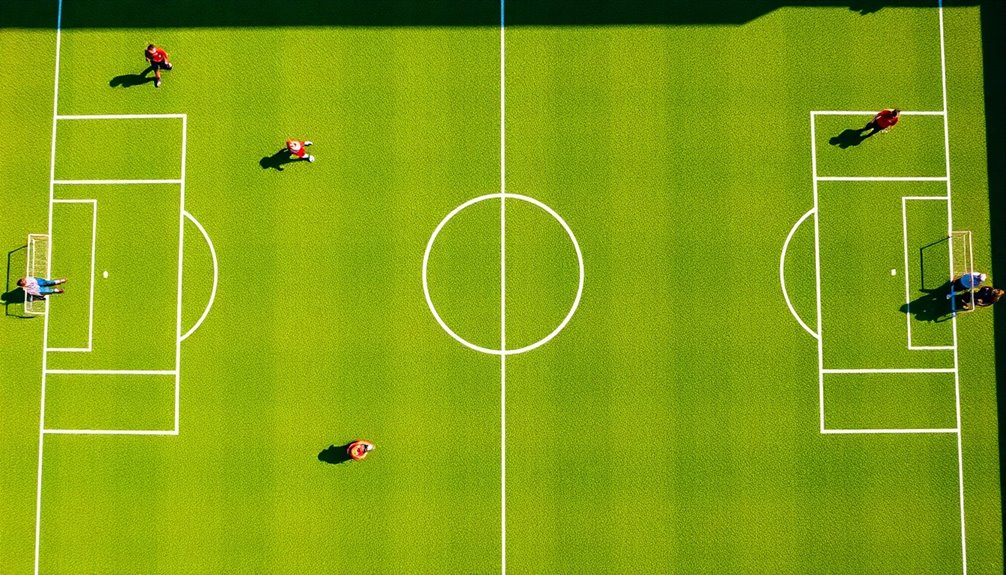
Understanding Soccer Field Markings for Players and Coaches
February 25, 2025Understanding soccer field markings is essential for both players and coaches. These markings define key areas like the penalty area, goal area, and center circle, influencing your strategies during set plays and restarts. Knowing where to position yourself during kickoffs or before taking a corner kick can give you a competitive edge. The dimensions and rules around each marking dictate how the game flows. There's much more to explore about how these markings can shape your game.
The Importance of Field Markings in Soccer
While you mightn't think about it during a game, field markings play an essential role in soccer.
Soccer field markings define the boundaries of the field of play, ensuring that the entire ball must cross the touchlines or goal lines for the game to pause. The penalty area is important, as it dictates where the goalkeeper can use their hands and where fouls lead to penalty kicks. Understanding field dimensions is crucial as it sets the foundation for how these markings are applied.
The center circle maintains a minimum distance during kickoffs, promoting fair play. Your understanding of the goal area is significant, as goal kicks can be taken from within this box. Additionally, recognizing the dimensions of the goal area is crucial for understanding its impact on set pieces and defensive strategies.
Finally, being aware of the penalty spot's precise location helps in strategizing during critical penalty situations, making these markings integral to the game.
Understanding the Goal Area
When you're on the field, understanding the goal area is essential for executing goal kicks correctly.
You can place the ball anywhere inside this 6-yard box, but remember that the opposing team must stay outside until the ball's in play. This area not only influences how goal kicks are taken but also plays a role in indirect free kicks and the goalkeeper's actions. Additionally, the goalkeeper's hands can be used within this area, which is crucial for managing defense during set pieces. The penalty area guidelines further define the limitations and responsibilities of players in this vital zone. Furthermore, players must be aware that improper positioning in this area can lead to penalty kick consequences if a handball is called during set pieces.
Goal Kick Execution
Understanding the goal area is essential for executing a goal kick effectively. This area, also known as the 6-yard box, extends 6 yards from the goal line and is 20 yards wide.
When taking a goal kick, you can place the ball anywhere within this goal area or on the line. Remember, players from the opposing team must stay outside the penalty area until the ball is in play.
A goal kick is awarded when the ball crosses the goal line without scoring and was last touched by an attacking player. As an indirect free kick, the ball must touch another player before a goal can be scored directly from your kick.
Make sure to execute it correctly for a smooth restart!
Placement Regulations
The placement of the ball during goal kicks is essential for ensuring a smooth restart of play.
In the goal area, which measures 6 yards from the goal line and 20 yards wide, you can place the ball anywhere within this space or on its line. It's vital to remember that the ball must be placed correctly for the kick to count.
If an indirect free kick is awarded within the goal area, the ball must be placed at the top of the goal area, serving as the starting point for that kick.
Additionally, any fouls in this area can lead to penalties for the attacking team, emphasizing the importance of understanding these placement regulations.
Indirect Free Kick
Indirect free kicks play an essential role in soccer, especially within the goal area. This area, known as the 6-yard box, is vital for goal kicks and affects both the defending and attacking teams' strategies.
When an indirect free kick is awarded within the goal area, it's taken from the top, 6 yards from the goal line. Players need to be aware of their positions, as the goal area is part of the larger penalty area, influencing fouls and the goalkeeper's ability to use their hands.
Understanding the layout helps you and your teammates with strategic positioning, ensuring you capitalize on opportunities while minimizing risks during play. Always stay alert to the dynamics of this significant space!
Exploring the Penalty Area
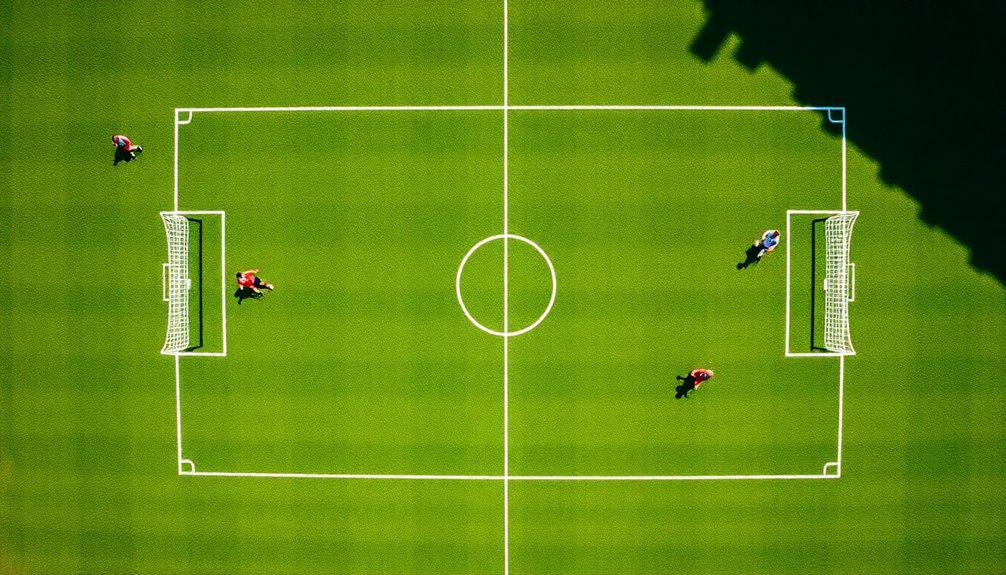
In soccer, the penalty area, often referred to as "the 18," plays a significant role in both offensive and defensive strategies. Measuring 18 yards long and 36 yards wide, it's where critical plays unfold. Understanding field dimension rules is essential to appreciate how the penalty area influences gameplay.
When a foul occurs within this area, a penalty kick is awarded, with the penalty spot located 12 yards from the goal line. As a goalkeeper, you can use your hands only within the penalty area; touching the ball outside results in a handball violation. This area is also where fouls lead to penalties that can change the course of the game.
During a penalty kick, all players except the shooter and the defending goalkeeper must remain outside the penalty area and the penalty arc, which extends 10 yards from the penalty spot.
The goal area, 6 yards from the goal line, is also essential for goal kicks. Understanding the significance of the penalty area is crucial for both players and coaches in developing strategies during matches.
The Significance of the Penalty Spot
The penalty spot plays a vital role in the game, marking where you take a penalty kick from 12 yards away. It's important to know that only the shooter and the goalkeeper can be positioned near the spot during this high-pressure moment, while others must stay back. Understanding these rules and the significance of distance helps maintain fairness and excitement in soccer. Additionally, mastering shooting techniques can significantly improve the chances of scoring during penalty kicks. The moment of the penalty kick can also be influenced by the defensive wall formation, which is crucial for understanding how to maximize scoring opportunities. Furthermore, players should be aware that the distance rules ensure that the goalkeeper remains on their line until the kick is taken, adding to the challenge for the shooter.
Penalty Kick Procedure
While many aspects of soccer are governed by intricate rules, the penalty kick procedure centers around the significance of the penalty spot. Located 12 yards from the goal line within the penalty area, it's essential for executing penalty kicks.
When the referee signals the kick, only the shooter and the goalkeeper are allowed in the penalty area; players must remain outside the penalty arc, which extends 10 yards from the penalty spot. The kick must be taken directly, without feints or delays.
If the ball strikes the goalpost or crossbar and stays in play, the match continues, but improper positioning can lead to a retake. The success rate for penalty kicks usually hovers between 70% and 80%, influenced by shooter confidence and goalkeeper skill.
Player Positioning Rules
Understanding player positioning rules during a penalty kick is essential for both shooters and defenders.
The penalty spot, located 12 yards from the goal line, is where the shooter places the ball for the penalty kick. When the kick is about to be taken, all players except the shooter and the goalkeeper must stand outside the penalty area and the penalty arc, which extends 10 yards from the penalty spot.
The referee signals when the kick can occur. Be aware that if defenders encroach into the penalty area or arc before the kick, it may lead to a re-kick if the shot is missed or saved.
Proper player positioning is vital for maintaining fair play on the soccer field.
Importance of Distance
Located 12 yards from the goal line, the penalty spot plays an essential role in soccer by serving as the designated point for penalty kicks. During these critical moments, understanding the importance of distance is essential.
- Players must stay outside the penalty arc, which extends 10 yards from the penalty spot, to guarantee fair play.
- The goalkeeper's position at the penalty spot can greatly impact the penalty kick's outcome.
- Fouls committed within the penalty box lead to penalty kicks, creating significant scoring opportunities for the attacking team.
What You Need to Know About the Penalty Arc
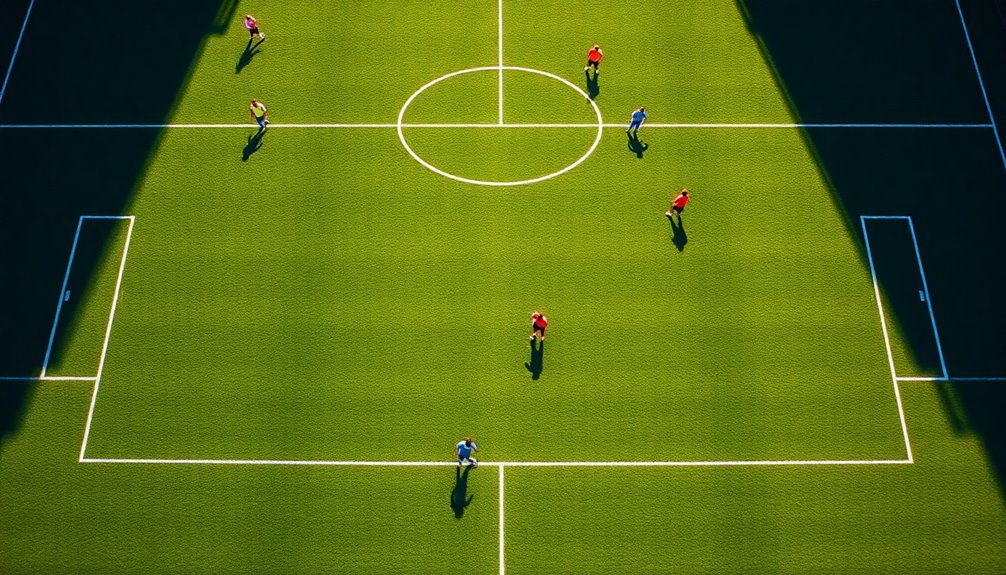
When it comes to penalty kicks, knowing the rules surrounding the penalty arc is vital for both players and spectators alike.
The penalty arc extends 10 yards from the penalty spot, creating a semi-circular boundary outside the penalty area where players must maintain distance during a penalty kick. Only the shooter and the defending goalkeeper can be within this area; all other players must remain outside the penalty arc to guarantee fair play. This boundary helps officials enforce rules regarding player positioning, preventing throw-in violations into the penalty area. Being aware of the penalty arc is important for players to avoid fouls or violations, allowing the shooter a clear opportunity to take the kick while upholding the integrity of the game. Additionally, understanding throw-in rules can further enhance players' knowledge of game regulations and player positioning. The enforcement of the penalty arc is crucial for maintaining kickoff rules that ensure fair play and equitable opportunities during the game.
The Center Circle Explained
The center circle is an essential element of the soccer field, marking the spot where the game begins and restarts after a goal. With a radius of 10 yards, it plays a significant role during kickoffs.
Here are three key points to remember:
- Kickoff Rules: All opposing players must remain outside the center circle until the ball is in play, ensuring fairness.
- Player Positioning: Players must be positioned on their own half during a kickoff, emphasizing the center circle's function in game restart scenarios.
- Orderly Flow: The center circle helps maintain an orderly flow of the game, providing the necessary space for proper player positioning during these significant moments. Additionally, understanding the importance of stoppage time is crucial for players and coaches as it affects strategic decisions during kickoffs and restarts.
Understanding this area enhances your grasp of the game's dynamics on the soccer field.
The Role of the Halfway Line
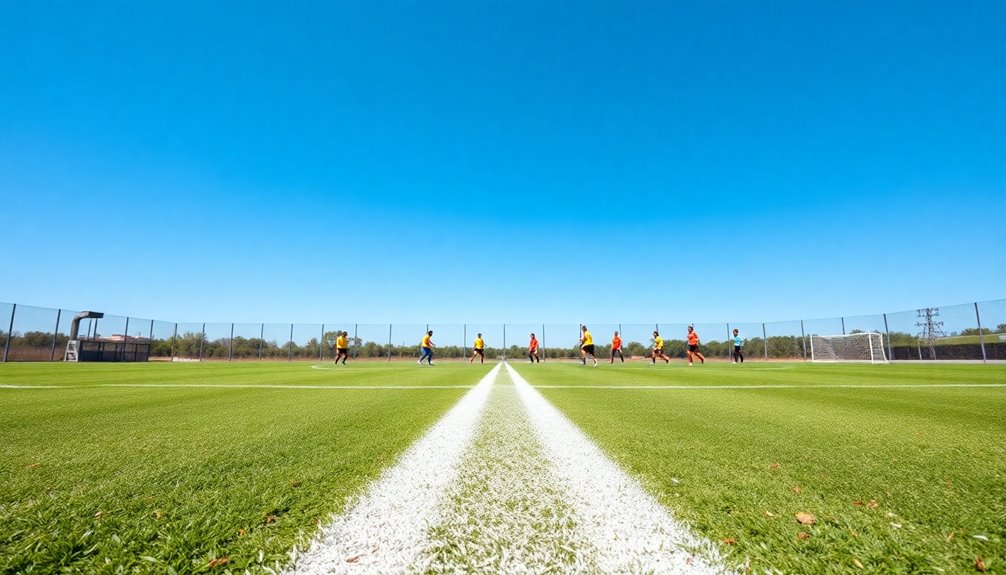
The halfway line plays a crucial role in how the game is structured, dividing the field and keeping players in their designated halves until the action begins.
It's also key for the offside rule, as players need to be aware of their positioning relative to this line when the ball is played.
Plus, it marks the spot for kickoffs, making it indispensable for starting the match and resuming play after goals or halftime.
Field Division Importance
While you mightn't notice it at first glance, the halfway line plays an essential role in soccer by dividing the field into two equal halves. This field division is vital for maintaining game structure and order.
Here are three key aspects of the halfway line's importance:
- Designated Areas: Players must remain in their respective halves until the ball is in play, ensuring the game runs smoothly.
- Team Tactics: The halfway line influences strategic formations, guiding teams in positioning their players effectively.
- Offside Positions: Understanding the halfway line helps players know when they can be in offside positions, impacting their movements during significant plays.
Offside Rule Application
Understanding the offside rule can be tricky, especially when you consider how the halfway line plays an essential role in determining player positioning.
During a kickoff, all players must stay in their own half until the ball is in play, ensuring that they're correctly positioned according to the offside rule. A player's offside status is assessed based on their proximity to the opponent's goal line relative to the ball and the second-to-last opponent.
The halfway line helps officials evaluate these situations, promoting fair play. During a free kick, players must also respect the halfway line until the kick is taken, reinforcing its significance in avoiding penalties and maintaining game integrity.
Kickoff Procedures Explained
Kickoff procedures are essential for setting the tone of the game, and the halfway line plays a pivotal role in this process. The kickoff occurs at the center mark, and it's significant for players to understand their positioning.
Here are three key points to remember:
- Player Positioning: All players must be in their own half of the field during the kickoff.
- Distance Requirement: Opposing players need to stay at least 10 yards away from the ball until it's kicked.
- Ball Movement: The ball must move forward one full rotation for the kickoff to be valid.
If a kickoff isn't executed correctly, the referee will stop play and require a retake, ensuring all rules are followed.
Understanding the Sideline
The sideline, or touchline, is essential in soccer, marking the boundary where the ball must fully cross for a throw-in to occur. This line runs the length of the soccer field, and it's important for players to understand its role.
When the ball crosses the sideline, a throw-in is awarded, but remember, both feet of the player taking the throw-in must remain on or behind the line. Players can be off the field during this process, but the ball must stay within the touchline boundaries to remain in play.
Coaches are also restricted to the technical area, which extends 1 yard from the touchline, ensuring they don't interfere with play or officials during the match.
The Function of the Endline
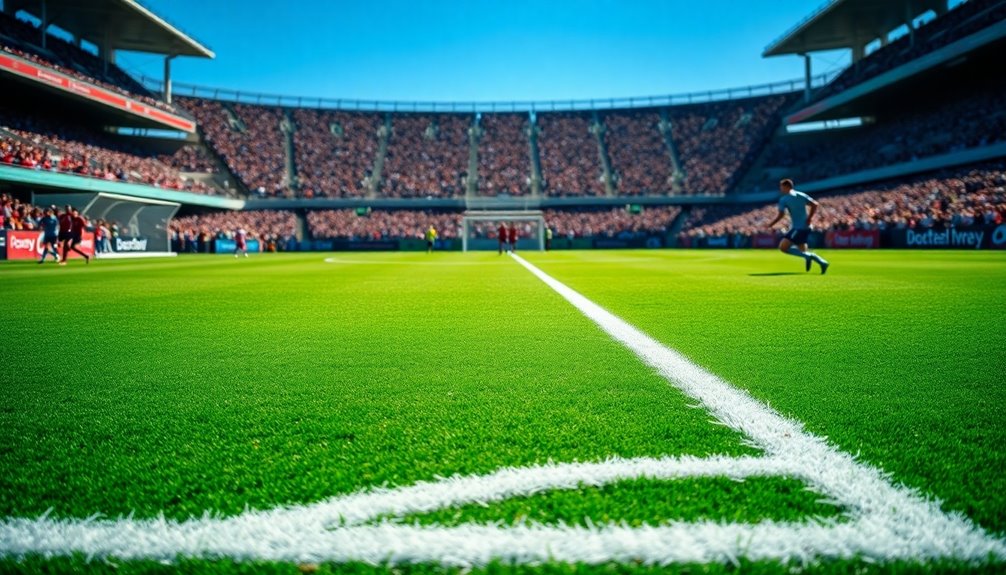
While you may focus on the action during a soccer match, the endline plays an essential role in the game's dynamics.
Understanding the function of the endline is important as it influences key game situations:
- Scoring: The endline, or goal line, is where goals are located, marking the area for scoring.
- Goal Kicks: If the ball crosses the endline without a goal, and last touched by an attacking player, a goal kick is awarded, taken from the goal area.
- Corner Kicks: Conversely, if the last touch comes from a defending player, a corner kick is given.
It's significant to remember that the goalposts must be on the endline, standardized at 8 yards apart, directly impacting gameplay on the soccer field.
The Corner Mark: An Essential Element
Corner marks serve as vital indicators on the soccer field, guiding players during set-piece situations. Each corner mark is a quarter-circle with a 1-yard radius from the corner flag, indicating where corner kicks are taken.
When the ball crosses the goal line after being touched by a defender, the attacking team is awarded a corner kick at the nearest corner mark.
It's important to remember that players from the defending team must stand at least 10 yards away from the corner arc during the kick to guarantee fair play.
The corner area allows the ball to be placed anywhere within the arc or on the line, making it essential for players and coaches to understand its regulations for effective strategies.
Key Dimensions of a Soccer Field
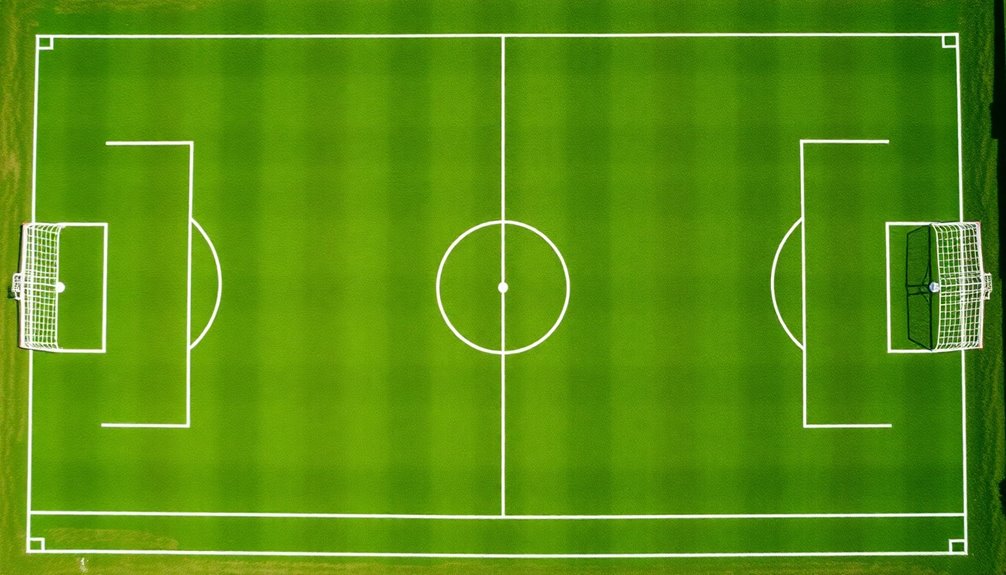
Understanding the key dimensions of a soccer field is essential for players, coaches, and fans alike.
Soccer field dimensions vary, but here are some critical measurements you should know:
- Penalty Area: The "18-yard box" measures 18 yards long and 36 yards wide, where the goalkeeper can use their hands and fouls lead to penalty kicks.
- Center Circle: With a radius of 10 yards, this circle guarantees opposing players maintain distance during kickoffs.
- Goal Area: Known as the "6-yard box," it extends 6 yards from the goal line and is 20 yards wide, serving as the area for goal kicks.
Understanding these soccer field lines helps you navigate the game more effectively!
How Markings Influence Game Strategy
Markings on a soccer field play an essential role in shaping game strategy, as they dictate how players position themselves and interact during various phases of play.
The center circle creates strategic space during kickoffs, forcing opponents to stay back. In the penalty area, defensive strategies are critical; fouls can lead to penalty kicks, which are taken from the penalty spot, just 12 yards from the goal.
Understanding the goal area aids in designing set pieces, while the penalty arc influences how defenders position themselves during penalties.
Ultimately, the corner area allows for offensive strategies; teams can exploit formations based on their proximity to the arc, maximizing their chances to score.
Conclusion
In soccer, understanding field markings is like knowing the rules of a game of chess; it's essential for outsmarting your opponent. Each line and area serves a purpose, guiding your movements and strategies on the pitch. By familiarizing yourself with these markings, you can enhance your gameplay, whether you're a player or a coach. So, next time you step onto the field, remember that these markings are your allies in crafting smart plays and seizing victory.


